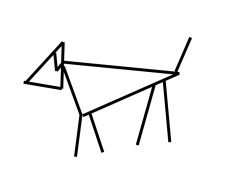Last week in Australia, the New South Wales state parliament passed a motion to make greyhound racing (and associated activities) illegal in the state from July 1st, 2017. I’ve got a few things to say about that, and I hope you’ll read along where ever you sit in this debate.

Our sooky Grey, Atlas
A Special Commission of Inquiry
Doubtless you heard that there was an inquiry into the state of greyhound racing in NSW after the Four Corners program got a lot of people thinking about a) the welfare of dogs (and other animals) within the racing industry and b) the level of policing within the industry. The inquiry was headed by a guy called Michael McHugh, who has been a practicing lawyer for 55 years, and a justice of the high court for many of those years. This inquiry started in May 2015 and took over a year to complete, with the report being delivered on June 16th 2016.
The report prepared by McHugh (including information from hundreds of individuals, organisations, government bodies and industry participants) is an epic 3 volumes (747 pages in total), available to the public here. Why is it available to the public? Because it should be public knowledge, and if you have an opinion about greyhound racing, you should read it. If you don’t have the time or patience, try this summary sheet instead.
Whether you read the whole report or just a summary, there are facts that stand out. While the report is limited in terms of exact numbers (due to the incompetence of Greyhound Racing NSW and some industry participants in keeping appropriate records), the overall message is clear. In the last 12 years, 50 to 70% of greyhounds (read 40-60 THOUSAND) were euthanised due to being uncompetitive (whether this is failure to chase, not being fast enough, injury, etc). That’s an average of 3333 dogs a year – even at a low ball estimate this is around the same number (3435) of dogs euthanised by the RSPCA in NSW during 2014/2015 for serious medical, behavioural and legal reasons. This alone should be enough to convince anyone – whether part of the industry or not – that greyhound racing results in an unacceptable number of healthy dogs being euthanised.
This is the tip of the iceburg – if this doesn’t convince you that the sport is not being operated with the welfare of the dogs as the primary interest, I encourage you to read the report. It highlights the lack of effort put into tracing the lives and final outcomes of individual dogs, the prolific use of home remedies instead of veterinary attention for medical concerns and responses by GRNSW which demonstrate their concern for public perception over improvements in welfare. The outcome of the inquiry was that the NSW premier, Mike Baird, immediately announced an end to greyhound racing in the state. State parliament passed that motion as a law last week, so yes, it’s actually happening.
What it means for greyhounds
Greyhound Racing NSW have announced a supplement to the Greyhound Racing Prohibition Act (2016), which prohibits an owner from euthanising a greyhound without express written content from GRNSW. This is, I would assume, hoped to be a safeguard against mass euthanasia once greyhounds lose their monetary value. It’s a step in the right direction, but there’s no mention of how difficult (or easy) it would be to obtain written consent. Overall, I think the end of the industry means that a lot of greyhounds will be euthanised. Yes, probably less than if the industry continued for another 10 years, but a lot of dogs will still die.
Greyhounds as Pets, the industry supported rehoming program, didn’t really start up until 2008. In the 8 years it’s been operating GAP has been increasing the number of adoptions every year – but almost a decade worth of adoptions only adds up to 593 dogs according to the inquiry report. Projected estimates for adoptions by the end of this year are 435 dogs – just 5.5% of the number born on average each year. Only another 4.3% are believed to be rehomed by independent adoption groups. Even if private rehoming made up another 20% of retiring dogs, that’s still 70% of dogs unaccounted for. What it all means is that rehoming programs are already unable to deal with the number of dogs looking for homes and the end of racing will see a surge in that number.
Greyhounds can go one of three ways; be moved interstate to continue racing, become a pet (by private adoption, or through a rehoming group) or be euthanised. That’s it. What we need to do is make sure that for the vast majority of dogs, it’s option a or b.

Our last foster dog, Ivy
What it means for all of us
This decision comes as a light at the end of the tunnel for some; for others, it’s a horrible blow that may find them jobless within 12 months. Just consider that – whatever side of the fence you’re on, there’s someone on the other side. We all tend to get heated in this argument, but in the end what matters is that the people and the animals involved in the industry are given respect and handled appropriately as it winds down.
For people involved in the industry as breeders, owners, trainers and punters, life will no doubt change. For the rest of us, it probably won’t. Some people will lose a hobby, other people will lose a main source of income. Others may choose to move interstate, a big decision with significant financial cost. What I have to say to those people is firstly, I’m sorry you have to give up something you obviously enjoyed, and I hope that you can find your feet financially. Secondly, is that now is the time for action – don’t plan for any further litters and start trying to line up homes for your existing dogs early, because come next July, there will be thousands of dogs looking for homes. Now is not the time to try and rally, to change the industry or to argue the figures – the ban just became state law, so it’s your responsibility to take care of your dogs, not bicker about it.
What about those of us who have supported a ban from the outset? It’s time to put your opinions into practice. Adopt a greyhound. Convince your friends, family, coworkers, neighbors and random people on the street that they need a greyhound in their lives. It’s not hard – they are amazing pets (see here). Foster if you can to help increase the capacity of rehoming organisations. Volunteer at the kennels of adoption groups, hold a fund raiser and just generally do what you can.
Spread the love
Please get involved. I adopted Atlas from the NSW Greyhounds as Pets program and couldn’t be happier – I have a wonderful companion for life. I also volunteer with them from time to time at events to encourage others to do the same and we have foster dogs with us at home when we can. This program is industry based and encourages owners and trainers to behave responsibly, working with them to find a permanent home for their hound. There are many others involved in greyhound rehoming, including the RSPCA, Greyhound Rescue, Friends of the Hound, Every Greyhound and many other all-breed shelters (e.g. Sydney Dogs and Cats home, local pounds, No Kill Pet Rescue, etc).

Our first foster, who we struggled to let go of, Trendy
With love,


